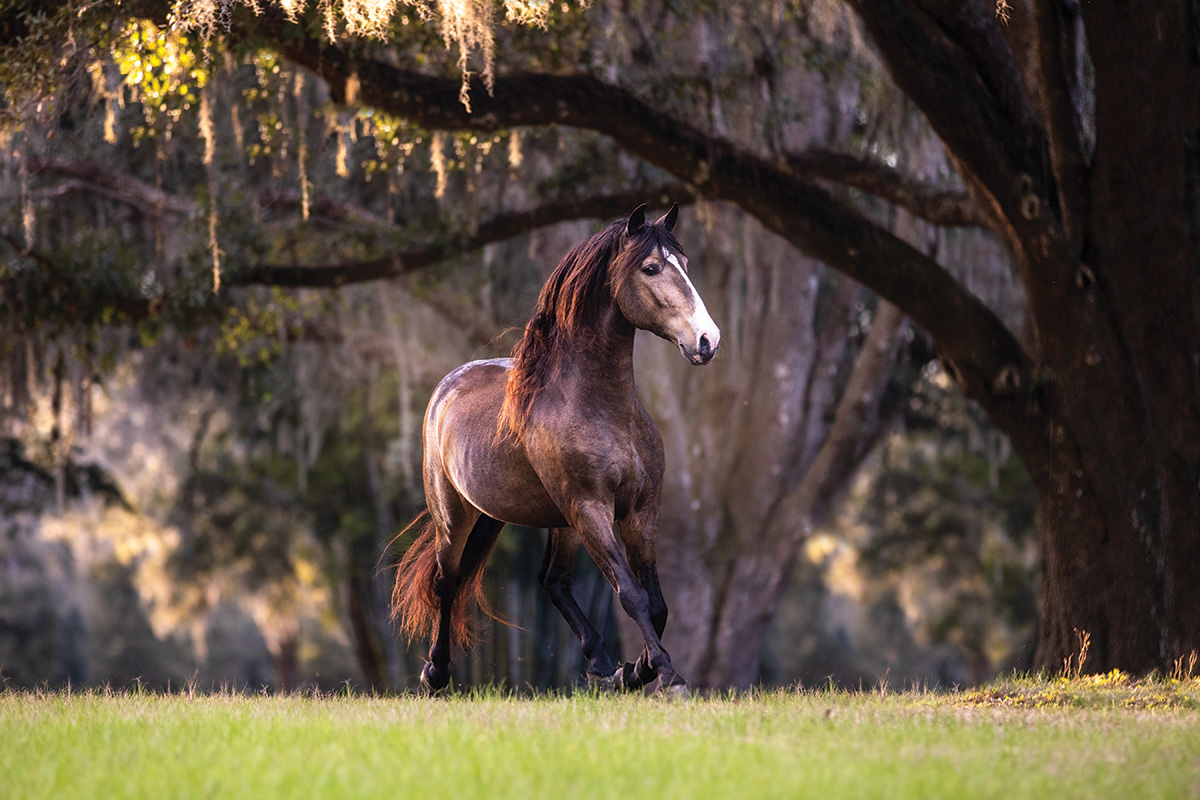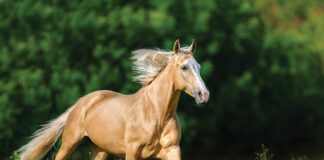
With a history spanning 25,000 years, the Lusitano’s roots run as deep as the trees on the Iberian Peninsula, where the horses’ adaptations to the unusual environment created a brave companion for humans. The Lusitano is one of the oldest riding horses, with evidence to show they have been ridden in what is now Portugal for at least the past 5,000 years.
Today, thousands of years later, the Lusitano is a very similar horse. The United States Lusitano Association (USLA) works with the Portuguese Breeder Association for the Lusitano (APSL) to help American and Canadian owners of Lusitanos get their horses registered and inspected for breeding if necessary.
This year, the USLA hosted their first USLA Lusitano Conference in February 2023 with internationally acclaimed instructors and Lusitano experts from around the world.

Lusitano, P.R.E., or Andalusian?
It’s easy to get the Lusitano, P.R.E., and the Andalusian confused. (P.R.E. stands for Pura Raza Española, which translates to Pure Spanish Horse.)
“The Andalusian is an American breed created and managed by the International Andalusian and Lusitano Horse Association (IALHA),” explains Sheri Prucka, USLA President. “[IALHA] permits the crossing of various Iberian breeds, including the Lusitano, P.R.E., and others to create purebred Andalusians. The term ‘Andalusian’ has historically been applied to horses from the region of Andalusia in the southern part of the Iberian Peninsula.” This is the southern end of modern Spain.
Prucka adds that it’s important to know that the P.R.E. is not the same as the Andalusian, and neither are Lusitanos. Lusitanos are registered with the APSL. But aside from names, she says the Lusitano differentiates from the other two breeds based on their natural collection and movement.

“The Lusitano stands apart based on the breed’s current results in competitive dressage, which stem from their clean gaits and natural collection that have developed from selective breeding focused on field work and the sport of bullfighting in Portugal,” Prucka explains. “Because of their history, Lusitanos tend to be brave and make excellent partners for their riders. Today, the focus of breeders has turned to dressage and working equitation, sports where the Lusitano excels.”

Star Lusitano Horses
Prucka shares that as of this past December, 43 of the 826 ranked Grand Prix dressage horses are APSL Lusitanos.
“Because of the natural collection of the Lusitano, they are an excellent choice for adult amateurs wishing to participate in higher level sports,” she says. “It’s generally easy to train them to execute the flying changes, piaffe, and passage that are required at higher levels, and riders don’t need as much physical strength as is required with most breeds.”
Candace Platz of Poland Springs, Maine, is the proud owner of three Lusitano Grand Prix stallions: Don Juan LAM, Beduino LAM and Enrique. Platz was encouraged to try Lusitanos by Rodrigo de Matos, a principal rider of The Escola Portuguesa de Arte Equestre.

“He invited me to Portugal to his training center to experience Lusitano horses, and that was the beginning,” she says. “The majority of my 2022 Grand Prix rides were without coaching and during a six-month hiatus where I had no instruction but trained on my own. The success of my year was not because I am a great rider—I am not—but because these horses are so game and solid in their work ethic that, as I say, ‘Any of them could throw down a decent Grand Prix dressage test in a Costco parking lot on any given Sunday.’”
Nancy Smith from Wellington, Fla., also owns a Grand Prix-level stallion, Eragon VO from Brazil. Smith got into Lusitanos because her sponsor, Sarah Bushong-Weeks, had one she wanted Smith to train. Now Smith has six Lusitanos in training, including Eragon.
“He has placed well in the CDI arena at the Global Dressage Festival and has just been named the No. 1 Lusitano at the Grand Prix level in the United States for 2022,” she says. “He also enjoys relaxing rides out around the mile track that surrounds the lake at the Palm Beach Equine Sports Complex where we board our horses. He has a wonderful character, is always a team player, and gives his best effort on a daily basis. He’s comfortable to ride and loves to work. He’s a rare combination of amateur-friendly and talented enough for a professional to compete internationally.”

At the 2020 Tokyo Olympic Games (held in 2021), Portugal’s dressage team was made up entirely of Lusitano horses. Other countries also had Lusitanos on their teams, including Brazil, Austria, Spain and Mexico, for a total of 14 horses representing the breed.
Therapy Horses
The Lusitano excels outside the dressage ring as well. The Shea Center for therapeutic riding in San Juan Capistrano, Calif., has two Lusitanos in their program. Both horses, a gelding named Shaw and a mare named Tess, came to them on loan and adapted so well they have stayed on.
“Lusitanos are a highly intelligent, trustworthy, athletic and versatile breed,” says Sarah Booth, communications director for the Center. “Their willing personalities and compact yet strong conformation combine to make them an ideal horse for our program. Their smooth gaits are optimal for a number of different diagnoses, including cerebral palsy, multiple sclerosis and stroke.”
This article about the Lusitano appeared in the April 2023 issue of Horse Illustrated magazine. Click here to subscribe!





